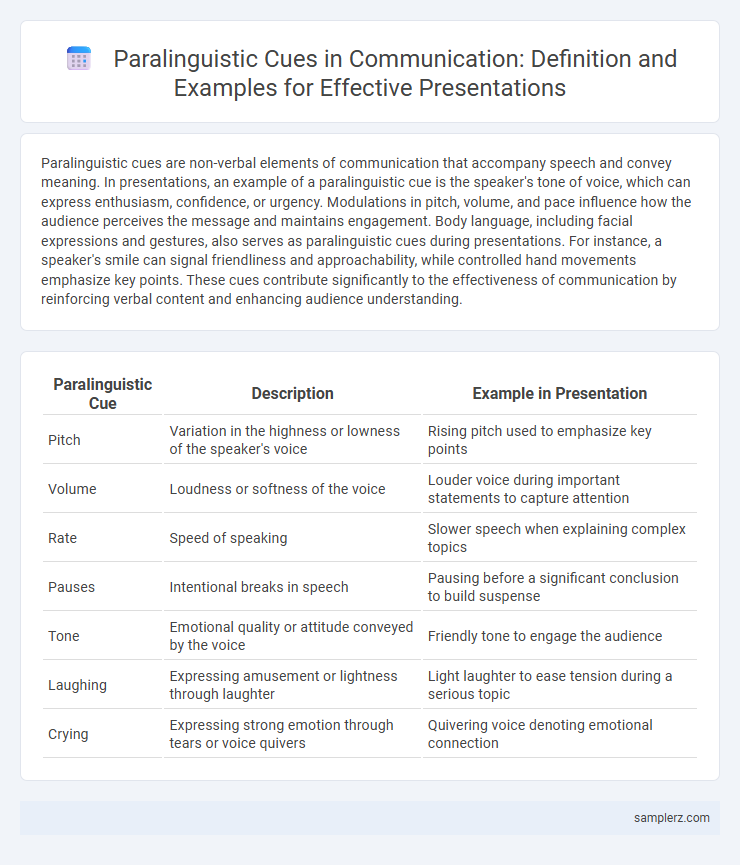Paralinguistic cues are non-verbal elements of communication that accompany speech and convey meaning. In presentations, an example of a paralinguistic cue is the speaker's tone of voice, which can express enthusiasm, confidence, or urgency. Modulations in pitch, volume, and pace influence how the audience perceives the message and maintains engagement. Body language, including facial expressions and gestures, also serves as paralinguistic cues during presentations. For instance, a speaker's smile can signal friendliness and approachability, while controlled hand movements emphasize key points. These cues contribute significantly to the effectiveness of communication by reinforcing verbal content and enhancing audience understanding.
Table of Comparison
| Paralinguistic Cue | Description | Example in Presentation |
|---|---|---|
| Pitch | Variation in the highness or lowness of the speaker's voice | Rising pitch used to emphasize key points |
| Volume | Loudness or softness of the voice | Louder voice during important statements to capture attention |
| Rate | Speed of speaking | Slower speech when explaining complex topics |
| Pauses | Intentional breaks in speech | Pausing before a significant conclusion to build suspense |
| Tone | Emotional quality or attitude conveyed by the voice | Friendly tone to engage the audience |
| Laughing | Expressing amusement or lightness through laughter | Light laughter to ease tension during a serious topic |
| Crying | Expressing strong emotion through tears or voice quivers | Quivering voice denoting emotional connection |
Introduction to Paralinguistic Cues in Presentations
Paralinguistic cues in presentations include variations in pitch, tone, and volume that enhance the speaker's message and audience engagement. For example, a deliberate slowdown in speech during key points signals importance and helps emphasize critical information. Nonverbal sounds such as sighs or laughter also convey emotion and attitude, enriching the overall communication experience.
Importance of Nonverbal Elements in Communication
Paralinguistic cues, such as tone of voice, pitch, and volume, significantly enhance the effectiveness of presentations by conveying emotions and reinforcing the speaker's message. Nonverbal elements like facial expressions and gestures complement verbal communication, improving audience engagement and comprehension. Understanding and mastering these cues are critical for presenters aiming to establish credibility and connect authentically with their audience.
Tone of Voice: Setting the Mood
Tone of voice in presentations serves as a crucial paralinguistic cue by conveying emotions and attitudes beyond spoken words. Variations in pitch, volume, and pace directly influence audience engagement and effectively set the mood of the message. Mastering tone modulation enhances communication impact, making the presentation more persuasive and memorable.
Volume Variations: Highlighting Key Points
Volume variations serve as an essential paralinguistic cue in presentations by emphasizing crucial information and guiding audience attention. Increasing the speaker's volume at pivotal moments enhances message retention and signals importance without altering the verbal content. Subtle shifts in loudness create a dynamic delivery that reinforces key points and maintains audience engagement.
Speech Rate: Controlling Audience Engagement
Speech rate, a key paralinguistic cue, significantly influences audience engagement during presentations by regulating the pace at which information is delivered. A moderate speech rate ensures clarity and allows listeners to process complex ideas without feeling overwhelmed. Varying the speed strategically can emphasize important points and maintain audience interest throughout the presentation.
Pauses and Silence: Creating Impact
Pauses and silence serve as powerful paralinguistic cues in presentations, enabling speakers to emphasize key points and give the audience time to process information. Strategic use of silence can heighten suspense, reinforce messages, and improve overall engagement by controlling the rhythm and flow of speech. Research shows that well-timed pauses enhance audience retention and create a more impactful communication experience.
Intonation Patterns: Conveying Emotions
Intonation patterns in presentations serve as crucial paralinguistic cues that convey emotions such as enthusiasm, confidence, or concern through rises and falls in pitch. Variation in tone helps emphasize key points, engage the audience, and clarify the speaker's attitude beyond mere words. Effective use of intonation enhances message reception and emotional connection during communication.
Facial Expressions: Enhancing Verbal Messages
Facial expressions serve as a powerful paralinguistic cue during presentations by conveying emotions and reinforcing the speaker's verbal messages. Smiling can promote warmth and openness, while eyebrow raises signal surprise or emphasis, helping to maintain audience engagement. Subtle changes in facial muscles enhance understanding and provide visual feedback, making communication more effective.
Gestures and Body Language in Presentations
Effective use of paralinguistic cues such as hand gestures and body language enhances audience engagement and clarity in presentations. Gestures, including illustrative and emphatic movements, emphasize key points and reinforce verbal messages. Confident posture and purposeful movements convey credibility and maintain listener attention throughout the presentation.
Mastering Paralinguistic Cues for Effective Delivery
Mastering paralinguistic cues like tone, pitch, and volume enhances audience engagement during presentations by conveying emotions and emphasizing key points. Effective use of pauses and vocal inflections complements verbal messages, making communication clearer and more persuasive. Practicing control over these vocal elements significantly improves overall delivery and audience retention.

example of paralinguistic cue in presentation Infographic
 samplerz.com
samplerz.com